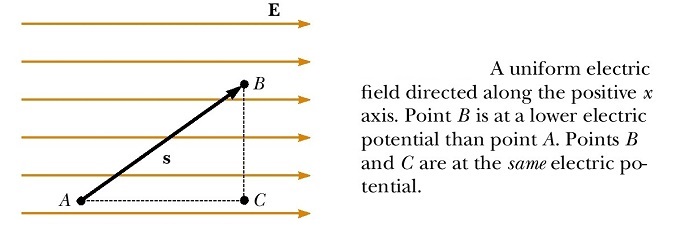Sign of Potential Difference: Difference between revisions
| Line 93: | Line 93: | ||
''potential-difference-in-uniform-electric-field''. Kshitij Education India. 22 Nov. 2015. | ''potential-difference-in-uniform-electric-field''. Kshitij Education India. 22 Nov. 2015. | ||
"Why Isn't There A standard Voltage around the World?" World Standards, 16 Aug. 2015. Web. 23 Nov. 2015. | |||
[[Category:Fields]] | [[Category:Fields]] | ||
Revision as of 21:35, 23 November 2015
Claimed by Wendy Sheu
This page provides an explanation to determine the sign of potential difference in which the sign shows whether energy is lost or gained by a moving charged particle.
The Main Idea
By determining the direction of path relative to the direction of electric field, the sign of potential difference can then be determined. The sign of potential difference then shows if there is an increase or a decrease in potential energy, as well as kinetic energy.
A Mathematical Model
Potential difference is the product of the electric field [math]\displaystyle{ \vec{E} }[/math] and the relative path [math]\displaystyle{ \Delta x }[/math]:
- [math]\displaystyle{ \Delta V }[/math] = -[math]\displaystyle{ \vec{E} }[/math]●[math]\displaystyle{ \Delta \vec{x} }[/math]
Sign of [math]\displaystyle{ \Delta V }[/math]
- [math]\displaystyle{ \Delta x }[/math] in the direction of [math]\displaystyle{ \vec{E} }[/math]: negative
- [math]\displaystyle{ \Delta x }[/math] in the opposite direction of [math]\displaystyle{ \vec{E} }[/math]: positvie
- [math]\displaystyle{ \Delta x }[/math] is perpendicular to the direction of [math]\displaystyle{ \vec{E} }[/math]: [math]\displaystyle{ \Delta V }[/math]=0
A Computational Model
Examples
Simple
If [math]\displaystyle{ x_i }[/math] = <3,0,0> m, [math]\displaystyle{ x_f }[/math] = <5,0,0> m, and [math]\displaystyle{ \vec{E} }[/math] = <100,0,0> V/m:
- (Path is in the same direction as the electric field.)
- [math]\displaystyle{ \Delta \vec{x} }[/math] = [math]\displaystyle{ x_f }[/math] - [math]\displaystyle{ x_i }[/math] = <5,0,0> - <3,0,0> = <2,0,0> m
- [math]\displaystyle{ \Delta V }[/math] = -[math]\displaystyle{ \vec{E} }[/math]●[math]\displaystyle{ \Delta \vec{x} }[/math] = -<100,0,0>●<2,0,0> = -200 V
If [math]\displaystyle{ x_i }[/math] = <5,0,0> m, [math]\displaystyle{ x_f }[/math] = <3,0,0> m, and [math]\displaystyle{ \vec{E} }[/math] = <100,0,0> V/m:
- (Path is in the opposite direction of the electric field.)
- [math]\displaystyle{ \Delta \vec{x} }[/math] = [math]\displaystyle{ x_f }[/math] - [math]\displaystyle{ x_i }[/math] = <3,0,0> - <5,0,0> = <-2,0,0> m
- [math]\displaystyle{ \Delta V }[/math] = -[math]\displaystyle{ \vec{E} }[/math]●[math]\displaystyle{ \Delta \vec{x} }[/math] = -<100,0,0>●<-2,0,0> = 200 V
If [math]\displaystyle{ x_i }[/math] = <3,0,0> m, [math]\displaystyle{ x_f }[/math] = <5,0,0> m, and [math]\displaystyle{ \vec{E} }[/math] = <0,100,0> V/m:
- (Path is perpendicular to the electric field.)
- [math]\displaystyle{ \Delta \vec{x} }[/math] = [math]\displaystyle{ x_f }[/math] - [math]\displaystyle{ x_i }[/math] = <5,0,0> - <3,0,0> = <2,0,0> m
- [math]\displaystyle{ \Delta V }[/math] = -[math]\displaystyle{ \vec{E} }[/math]●[math]\displaystyle{ \Delta \vec{x} }[/math] = -<100,0,0>●<0,2,0> = 0 V
Middling
If Location A = <3,0,0>, Location B = <5,-3,1> and E = <100, 100, 0>
- [math]\displaystyle{ \Delta \vec{x} }[/math] = [math]\displaystyle{ x_f }[/math] - [math]\displaystyle{ x_i }[/math] = <5,-3,1> - <3,0,0> = <2,-3,1> m
- [math]\displaystyle{ \Delta V }[/math] = -[math]\displaystyle{ \vec{E} }[/math]●[math]\displaystyle{ \Delta \vec{x} }[/math] = -<100,100,0>●<2,-3,1> = <-200,300,0> V
- In x-direction, there is an electric field in the same direction as the path, so the potential difference is negative.
- In y-direction, there is an electric field in the opposite direction of the path, so the potential difference is positive.
- In z-direction, since the electric field is perpendicular to the path, so the potential difference is zero.
Difficult
Connectedness
-Potential difference is connected to the concept of transmembrane potential which I am interested in. Potential difference between the outside and the inside of the cell membrane acts as a battery and provides important functions for us. The ion channels and ion pump proteins that are imbedded in the membrane allows ions to move across the membrane and creates concentration gradients, which then creates a potential difference that provides power to allow the transmission of the electric signals, such as those in our neurons and muscle cells. By opening and closing the ion channel, the signal is passed down to the next channels due to the change in potential. A brief video on this can be found here.
-As a Biomedical Engineering major, the concept of potential difference can be applied to the study of electric stimulation of cells. By causing the change in potential across the cells, voltage-dependent ion channels can be affected. From this concept, we can develop devices that are responsible for the signals of cells, such as a defibrillator.
-Industrial applications based on potential difference are again the devices that are used to affect the ion channels in which to allow activation or recovery of cell signals.
History
Put this idea in historical context. Give the reader the Who, What, When, Where, and Why.
See also
-Kinetic Energy and Potential Energy: The sign of potential difference shows whether energy is gained or lost from a moving particle. When there is an increase in potential energy [math]\displaystyle{ q \Delta V }[/math], there is a decrease in kinetic energy, and vice-versa.
-Polarization and Electric Field: Potential difference can be caused by polarization in which the charged particles move in different paths affect each other.
-Simple Circuits: Topics under simple circuits are mostly related to potential difference since batteries are involved, such as in RC circuit, Loop rule, and current.
Further reading
electric potential and capacitance
Matter & Interactions, Vol. II: Electric and Magnetic Interactions, 4nd Edition by R. Chabay & B.Sherwood (John Wiley & Sons 2015) (pp.635-637)
Dorf, Richard C. Sensors, Nanoscience, Biomedical Engineering, and Instruments. 3rd ed. N.p.: Taylor & Francis, 2006. Print.
External links
References
Matter & Interactions, Vol. II: Electric and Magnetic Interactions, 4nd Edition by R. Chabay & B.Sherwood (John Wiley & Sons 2015) (pp.635-637)
SB1, Knisley, Blitchington TF, Hill BC, Grant AO, Smith WM, Pilkington TC, and Ideker RE. "Result Filters." National Center for Biotechnology Information. U.S. National Library of Medicine, Feb. 1993. Web. 22 Nov. 2015.
potential-difference-in-uniform-electric-field. Kshitij Education India. 22 Nov. 2015.
"Why Isn't There A standard Voltage around the World?" World Standards, 16 Aug. 2015. Web. 23 Nov. 2015.
